Shrubs of the Adirondacks:
Leatherleaf (Chamaedaphne calyculata)
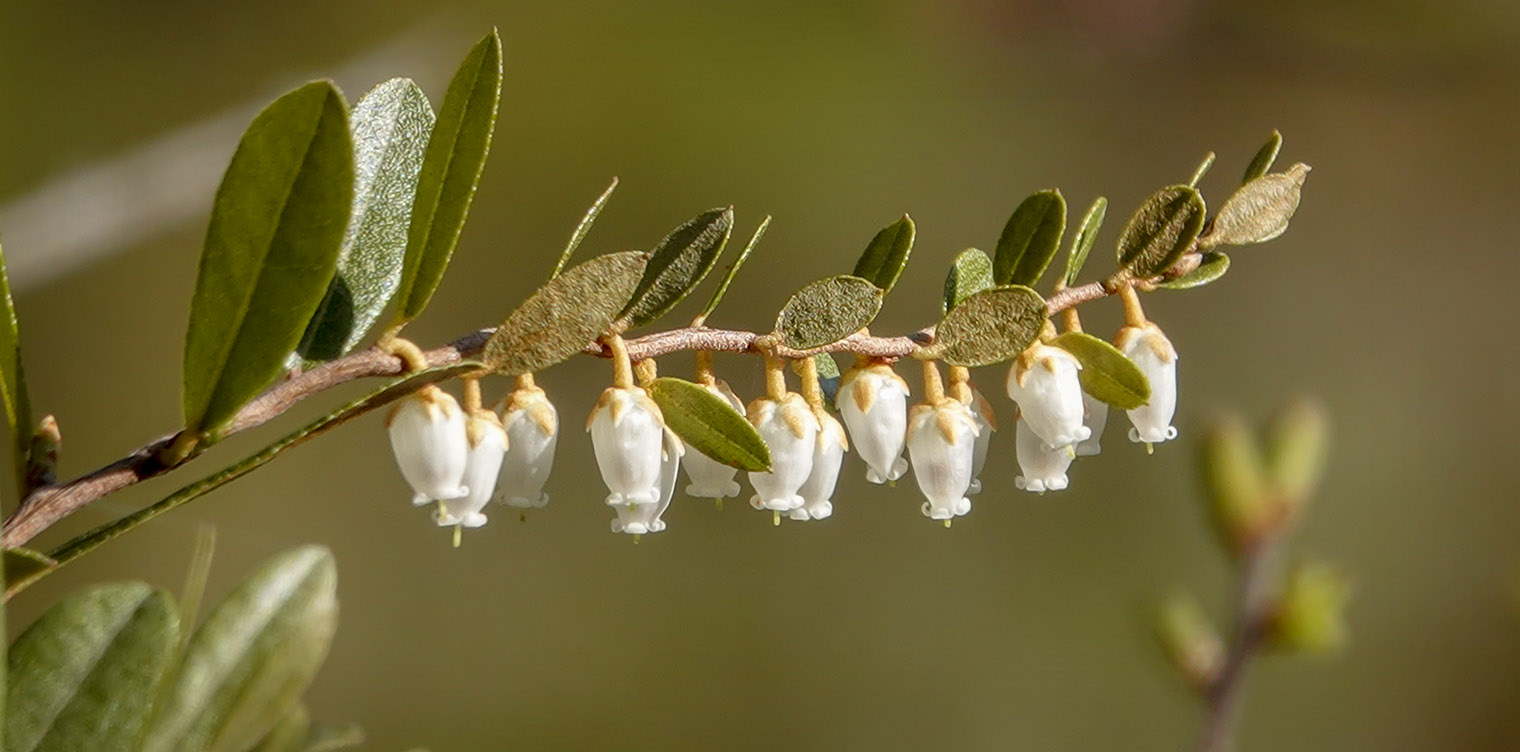
Leatherleaf (Chamaedaphne calyculata) is a native evergreen shrub which produces small, bell-shaped white flowers in spring. It grows in bogs and other wetland areas, as well as High Peaks summits, in the Adirondack Mountains of upstate New York.
Leatherleaf is a member of the Heath Family (Ericaceae). The genus name (Chamaedaphne) comes from the Greek meaning "ground laurel." The common name – Leatherleaf – is a reference to the plant's tough, leather-like leaf. This plant is also known as Cassandra.
Identification of Leatherleaf
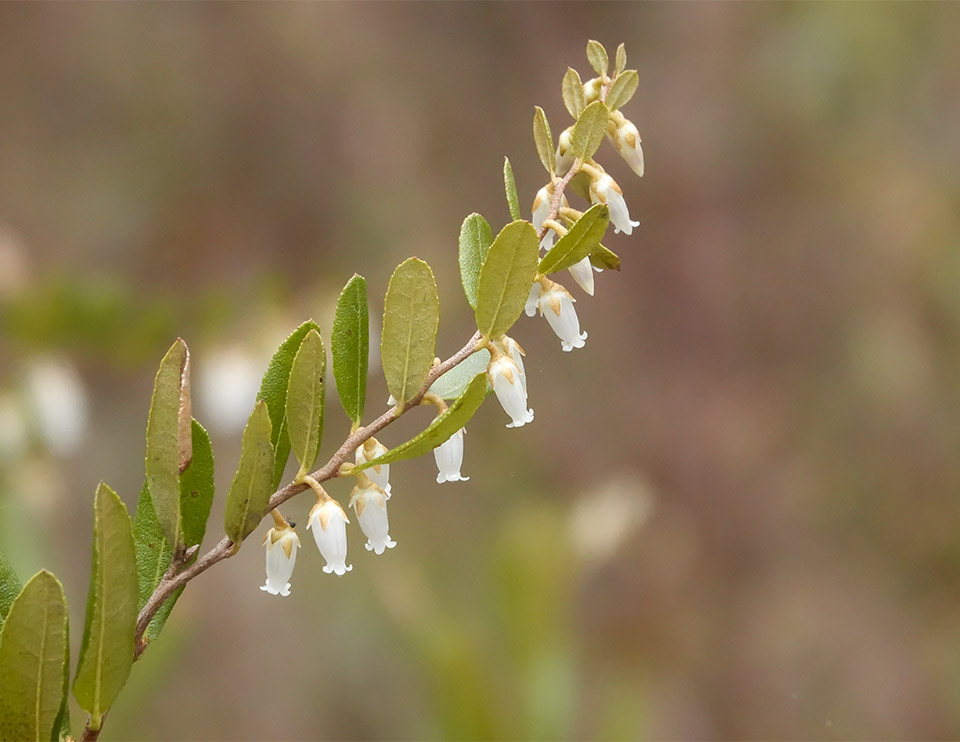
Leatherleaf forms a small, mound-shaped shrub up to three feet high. The stems are covered with tiny brownish scales. Leatherleaf has many branches and forms dense thickets. Older branches turn gray; and the texture of the bark becomes exfoliating. In alpine zones, the plant is much smaller, forming a miniature shrub.
The leaves of the Leatherleaf are alternate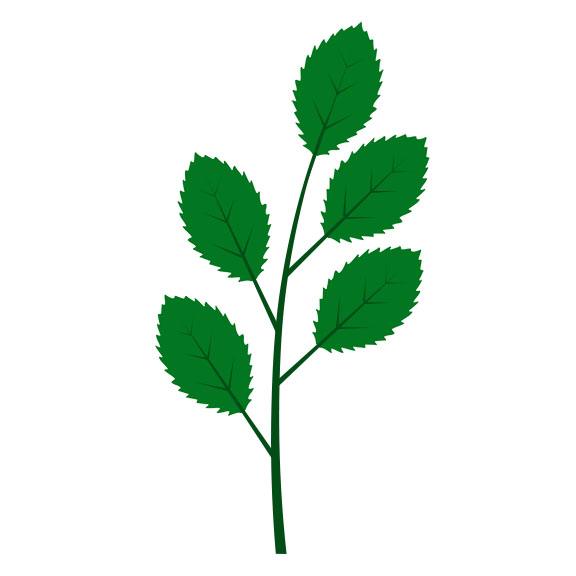 Alternate: An arrangement of leaves (or buds) on a stem (or twig) in which the leaves emerge from the stem one at a time. This often makes the leaves appear to alternate on the stem. and elongated oval or elliptical in shape. They are somewhat leathery in appearance. They generally are ¾ to 1½ inches long, and about ½ inch wide. The leaf marginsThe structure of the leaf's edge. (edges) are very finely toothed
Alternate: An arrangement of leaves (or buds) on a stem (or twig) in which the leaves emerge from the stem one at a time. This often makes the leaves appear to alternate on the stem. and elongated oval or elliptical in shape. They are somewhat leathery in appearance. They generally are ¾ to 1½ inches long, and about ½ inch wide. The leaf marginsThe structure of the leaf's edge. (edges) are very finely toothed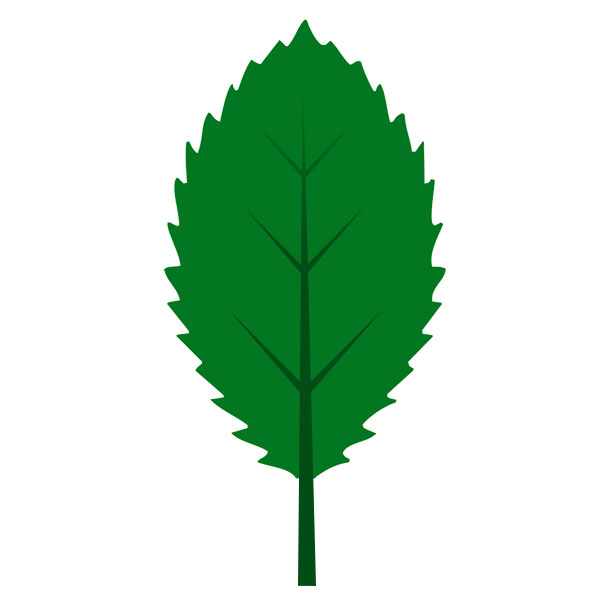 Toothed: Leaves which have a saw-toothed edge.. The upper surfaces of the leaf are dark green with a smooth sheen; the undersides have small brown scales. Older leaves are brownish bronze above and yellowish beneath. The foliage often turns red-brown winter.
Toothed: Leaves which have a saw-toothed edge.. The upper surfaces of the leaf are dark green with a smooth sheen; the undersides have small brown scales. Older leaves are brownish bronze above and yellowish beneath. The foliage often turns red-brown winter.
In spring, Leatherleaf produces nodding white flowers, which are about ¼ inch long and hang from the upper leaf axils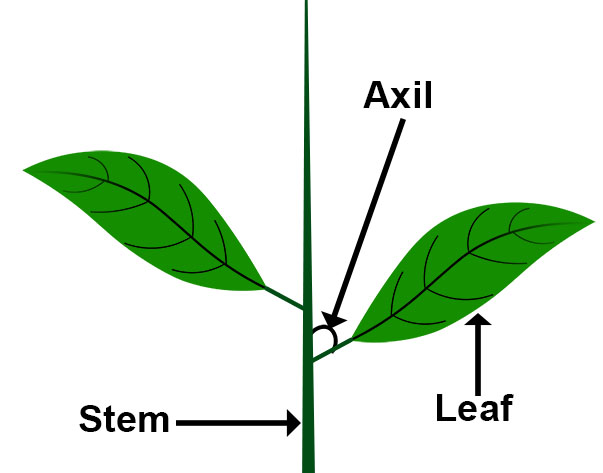 Axil: The angle between the upper side of a leaf or stem and the stem or branch that supports it. in one-sided, spike-like clusters. The tubular flowers are wider at the top than the bottom. The lips of the petals
Axil: The angle between the upper side of a leaf or stem and the stem or branch that supports it. in one-sided, spike-like clusters. The tubular flowers are wider at the top than the bottom. The lips of the petals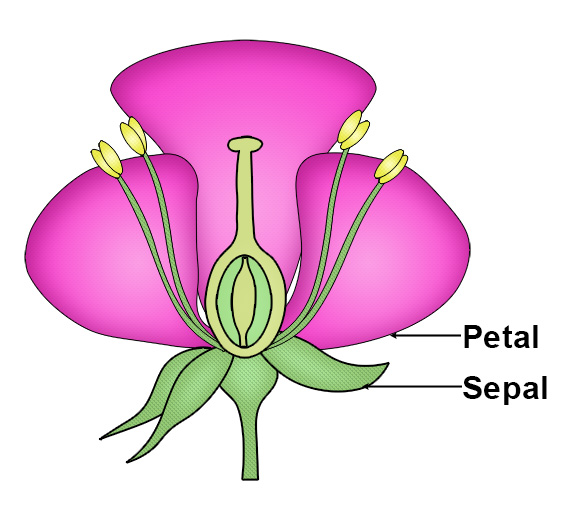 Petals: Modified leaves that surround the reproductive parts of flowers. Petals are often brightly colored or unusually shaped to attract pollinators. are rolled up at the bottom. The flowers sometimes have a pinkish tint.
Petals: Modified leaves that surround the reproductive parts of flowers. Petals are often brightly colored or unusually shaped to attract pollinators. are rolled up at the bottom. The flowers sometimes have a pinkish tint.
Leatherleaf usually blooms in the Adirondack region in late April or May, depending on the weather. A tally of flowering dates for the upland Adirondack areas compiled by Michael Kudish, based on data collected from the early seventies to the early nineties, lists the flowering time as 9 through 19 May in upland areas. Leatherleaf plants on High Peaks summits in the Adirondacks flower much later, usually in mid-June.
Leatherleaf produces fruit in August. The fruits are round, reddish capsules. They eventually turn brown, persisting through winter.
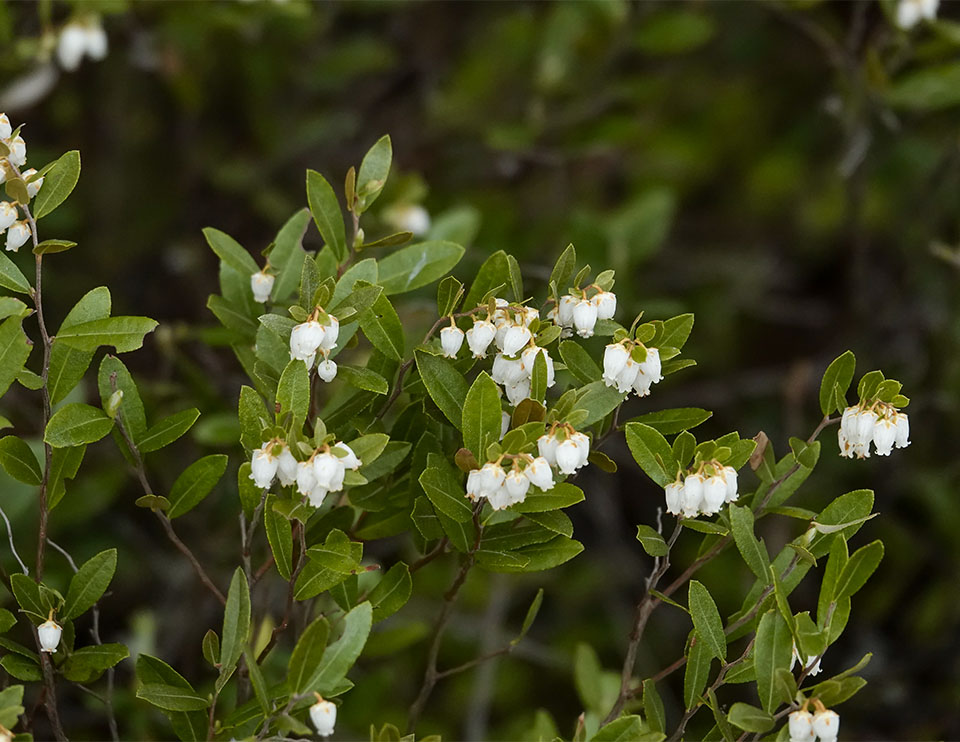
Leatherleaf is one of several leathery leafed plants growing in swampy or boggy habitats. Keys to identifying Leatherleaf and differentiating it from other leathery-leafed plants growing in these habitats include leaf arrangement, shape, and color, as well as the color and arrangement of the flowers.
- Several features differentiate Leatherleaf from Bog Laurel. Bog Laurel has opposite leaves, while Leatherleaf has alternate leaves. In addition, the leaves of the Leatherleaf are not distinctly in-rolled like those of Bog Laurel. The undersides of Leatherleaf leaves have small brown scales, contrasting with Bog Laurel leaves, which are whitish on the underside. The flowers of these two shrubs are also quite different. The white Leatherleaf bells appear on axils of the current year's leaves, forming a one-side raceme
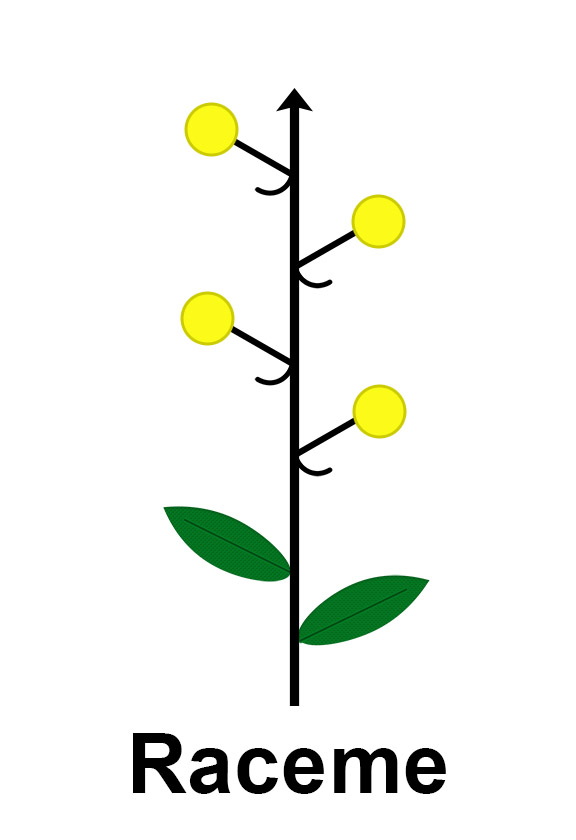 Raceme: A flower cluster with the separate flowers attached by short equal stalks at equal distances along a central stem. , while the pink Bog Laurel flowers appear in clusters at the end of the branch.
Raceme: A flower cluster with the separate flowers attached by short equal stalks at equal distances along a central stem. , while the pink Bog Laurel flowers appear in clusters at the end of the branch. - Leatherleaf can be distinguished from Sheep Laurel by the color and placement of its flowers. Sheep Laurel's crimson-pink flowers are quite different from Leatherleaf's white bells. In addition, Leatherleaf's alternate leaves contrasts with Sheep Laurel's opposite
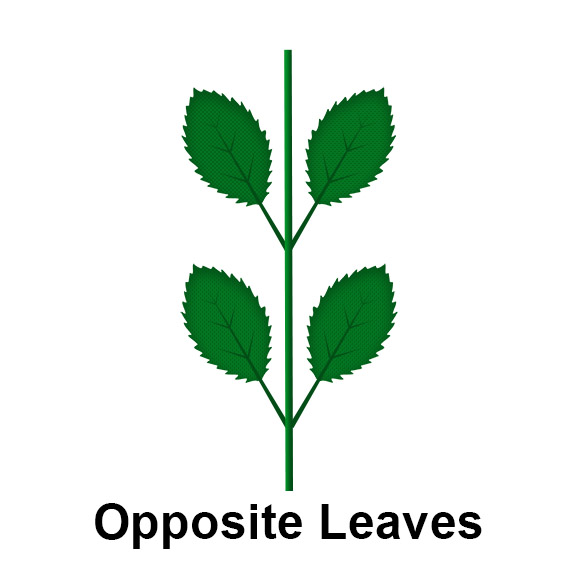 Opposite Leaves: Leaves occurring in pairs at a node, with one leaf on either side of the stem. or whorled
Opposite Leaves: Leaves occurring in pairs at a node, with one leaf on either side of the stem. or whorled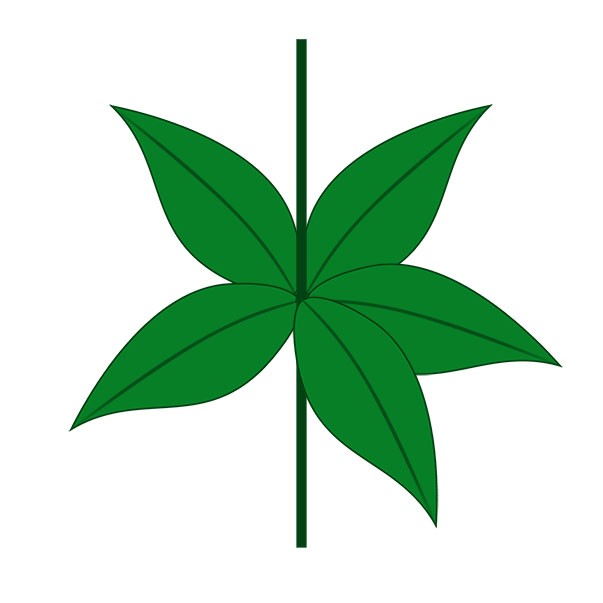 Whorled: Leaves arranged in a circle around a central point. leaves.
Whorled: Leaves arranged in a circle around a central point. leaves. - Leatherleaf can be distinguished from Labrador Tea by both the leaves and the flowers. Leatherleaf leaves are not in-rolled like the leaves of Labrador Tea. Also, the undersides of Leatherleaf leaves have small brown scales, contrasting with the dense mat of orange-brown hairs on the underside of Labrador Tea leaves. In addition, Leatherleaf leaves become progressively smaller toward the end of the current year's growth. Finally, Labrador Tea's cluster of five-petaled white flowers contrasts with the white bell-like flowers of Leatherleaf.
- Flower arrangement also helps distinguish Leatherleaf from Bog Rosemary. Bog Rosemary flowers are bell-shaped, like those of Leatherleaf, but are arrayed on the plant in a completely different way. The white Leatherleaf bells appear on axils
 Axil: The angle between the upper side of a leaf or stem and the stem or branch that supports it. of the current year's leaves, forming a one-side raceme
Axil: The angle between the upper side of a leaf or stem and the stem or branch that supports it. of the current year's leaves, forming a one-side raceme Raceme: A flower cluster with the separate flowers attached by short equal stalks at equal distances along a central stem. , while the pinkish Bog Rosemary flowers appear in clusters at the end of the branch. Leaves are another key to distinguishing between the two species when flowers are not present. Bog Rosemary's leaves are distinctly inrolled and are white on underside, contrasting with the rusty scales on the underside of Leatherleaf leaves.
Raceme: A flower cluster with the separate flowers attached by short equal stalks at equal distances along a central stem. , while the pinkish Bog Rosemary flowers appear in clusters at the end of the branch. Leaves are another key to distinguishing between the two species when flowers are not present. Bog Rosemary's leaves are distinctly inrolled and are white on underside, contrasting with the rusty scales on the underside of Leatherleaf leaves.
Uses of Leatherleaf
Leatherleaf has very limited edible uses. The fresh or dried leaves of Leatherleaf have been used to make a tea-like beverage. However, some reports indicate that a toxin called andromedotoxin can be released from the plant if it is infused in boiling water. For that reason, it is recommended that the leaves be placed in a jar of cool water and left in a sunny position to make sun-tea.
Leatherleaf has limited medicinal uses. Native American Indian tribes reportedly used Leatherleaf to treat some ailments. Some groups used an infusion of leaves for fevers and a poultice of leaves for inflammations.
Wildlife Value of Leatherleaf
Leatherleaf has moderate wildlife value.
- The plant is a minor part of winter browse for White-tailed Deer and Moose.
- Leatherleaf provides nesting cover for several bird species, including Mallards, American Black Ducks, and Ring-necked Ducks.
- Eastern Cottontails and Snowshoe Hares reportedly feed on the twigs and bark.
- Leatherleaf is the host plant for the Brown Elfin.
Distribution of Leatherleaf
Leatherleaf can be found in the north-eastern part of the US, west to the Great Lakes states. It is present in most provinces of Canada. This plant is listed as threatened in Illinois and Maryland.
Leatherleaf is found in nearly all counties in New York State. It occurs in all counties within the Adirondack Park Blue Line.
Habitat of Leatherleaf
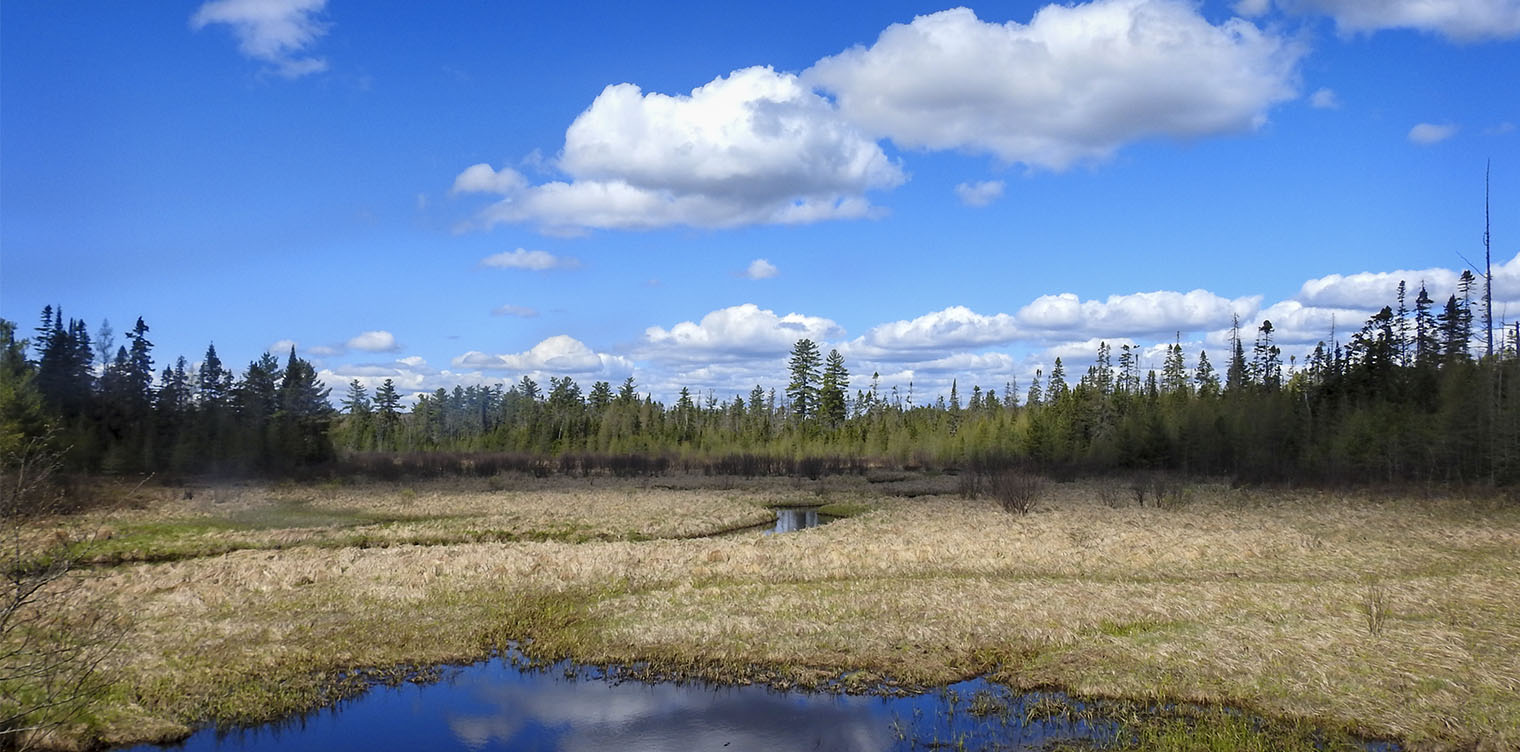
Leatherleaf is classified as an obligate (OBL) wetland species, meaning that it almost always occurs in wetlands. It is acid tolerant and shade intolerant. It among those plants which usually require a high water table and very wet soil. It appears to do best in boggy soils, but can also grow in alpine organic mats. It is also seen on lake, pond, and stream shorelines.
Leatherleaf is often the first shrub to enter a bog after sphagnum is established; this plant frequently plays a major role in extending the bog mat. Because it is shade intolerant, Leatherleaf usually begins to thin as tall shrubs or bog forest species such as Tamarack or Black Spruce become established on the site.
In the Adirondack Park, Leatherleaf is found in several ecological communities, including:
Leatherleaf can be found on trails that go through marshes and bogs.
- At the Paul Smith's College VIC, Leatherleaf may be seen along the margins of Heron Marsh, from the Heron Marsh Trail.
- Leatherleaf also grows on Barnum Bog, accessible from the Boreal Life Trail boardwalk, and on the margins of Black Pond (from the Black Pond Trail) and Long Pond (from the Long Pond Trail).
- You can also find Leatherleaf on the Bloomingdale Bog Trail.
- Leatherleaf also grows in the marshy areas on the shore of Heart Lake, accessible from the Heart Lake Trail.
Leatherleaf can also be found growing on the summits of Adirondack mountains in the High Peaks region, including Marcy, Algonquin, Wright, Iroquois, Coldin, Haystack, Basin, Saddleback, Gothics, Dix, and Whiteface.
References
Michael Kudish. Adirondack Upland Flora: An Ecological Perspective (Saranac, New York: The Chauncy Press, 1992), pp. 40, 54, 142.
New York Flora Association. New York Flora Atlas. Leatherleaf. Chamaedaphne calyculata (L.) Moench. Retrieved 3 January 2019.
United States Department of Agriculture. The Plants Database. Leatherleaf. Chamaedaphne calyculata (L.) Moench. Retrieved 10 April 2017.
United States Department of Agriculture. NRCS National Plant Data Center & the Biota of North America Program. Plant Guide. Leatherleaf. Chamaedaphne calyculata (L.) Moench. Retrieved 10 April 2017.
United States Department of Agriculture. Fire Effects Information System (FEIS). Species Reviews. Chamaedaphne calyculata. Retrieved 10 April 2017.
Flora of North America. Chamaedaphne calyculata (Linnaeus) Moench. Retrieved 10 April 2017.
NatureServe Explorer. Online Encyclopedia of Life. Leatherleaf. Chamaedaphne calyculata - (L.) Moench. Retrieved 10 April 2017.
New York State. Department of Environmental Conservation. New York Natural Heritage Program. Ecological Communities of New York State. Second Edition (March 2014), pp. 53-54, 55-56, 60, 60-61, 61-62, 63-64, 65, 76. Retrieved 17 October 2015.
New York Natural Heritage Program. 2021. Online Conservation Guide for Alpine Sliding Fen. Retrieved 7 May 2021..
New York Natural Heritage Program. 2021. Online Conservation Guide for Black Spruce-Tamarack Bog. Retrieved 7 May 2021.
New York Natural Heritage Program. 2021. Online Conservation Guide for Dwarf Shrub Bog. Retrieved 7 May 2021..
New York Natural Heritage Program. 2021. Online Conservation Guide for Inland Poor Fen. Retrieved 7 May 2021.
New York Natural Heritage Program. 2021. Online Conservation Guide for Medium Fen. Retrieved 7 May 2021.
New York Natural Heritage Program. 2021. Online Conservation Guide for Open Alpine Community. Retrieved 7 May 2021.
New York Natural Heritage Program. 2021. Online Conservation Guide for Patterned Peatland. Retrieved 7 May 2021.
New York Natural Heritage Program. 2021. Online Conservation Guide for Pine Barrens Vernal Pond. Retrieved 7 May 2021.
New York Natural Heritage Program. 2021. Online Conservation Guide for Red Maple-Tamarack Peat Swamp. Retrieved 7 May 2021.
New York Natural Heritage Program. 2021. Online Conservation Guide for Sedge Meadow. Retrieved 7 May 2021.
Connecticut Botanical Society. Leatherleaf. Retrieved 10 April 2017.
University of Wisconsin. Shrubs of Wisconsin. Leather-leaf. Chamaedaphne calyculata (L.) Moench. Retrieved 10 April 2017.
Minnesota Wildflowers. Chamaedaphne calyculata. Leather-leaf. Retrieved 10 April 2017.
Lady Bird Johnson Wildflower Center. Chamaedaphne calyculata (L.) Moench. Retrieved 10 April 2017.
Donald W. Stokes. The Natural History of Wild Shrubs and Vines. Eastern and Central North America (Harper & Row, Publishers, 1981), pp. 193-197.
Alexander C. Martin, Herbert S. Zim, and Arnold L. Nelson. American Wildlife & Plants. A Guide to Wildlife Food Habits (New York: Dover Publications, 1951), pp. 268-270.
John Eastman. The Book of Swamp and Bog: Trees, Shrubs, and Wildflowers of Eastern Freshwater Wetlands (Stackpole Books, 1995), pp. 104-107.
Plants for a Future. Chamaedaphne calyculata - (L.)Moench. Retrieved 10 April 2017.
University of Michigan. Native American Ethnobotany. A Database of Foods, Drugs, Dyes and Fibers of Native American Peoples, Derived from Plants. Leatherleaf. Chamaedaphne calyculata (L.) Moench. Retrieved 10 April 2017.
The Cornell Lab of Ornithology. Birds of North America. Subscription web site. Mallard; American Black Duck; Ring-necked Duck. Retrieved 10 April 2017.
Canadian Biodiversity Information Facility. Butterflies of Canada. Brown Elfin. Callophrys augustinus. Retrieved 10 April 2017.
Doug Ladd. North Woods Wildflowers (Falcon Publishing, 2001), p. 182.
Lawrence Newcomb. Newcomb's Wildflower Guide (Little Brown and Company, 1977), pp. 292-293.
National Audubon Society. Field Guide to Wildflowers. Eastern Region (Alfred A. Knopf, 2001), pp. 506-507.
William K. Chapman, et al. Wildflowers of New York in Color (Syracuse University Press, 1998), pp. 38-39.
William K. Chapman and Alan E. Bessette. Trees and Shrubs of the Adirondacks: A Field Guide (North Country Books, 1990), p. 95.
Meiyin Wu and Dennis Kalma. Wetland Plants of the Adirondacks. Ferns, Woody Plants, and Graminoids(Trafford Publishing, 2010), pp. 83-84.
Ronald B. Davis. Bogs & Fens. A Guide to the Peatland Plants of the Northeastern United States and Adjacent Canada (University Press of New England, 2016), pp. 108-109.
iNaturalist. Leatherleaf. Chamaedaphne calyculata. Retrieved 7 May 2021.
iNaturalist. Adirondack Park Observations. Leatherleaf. Chamaedaphne calyculata. Retrieved 7 May 2021.
John Krichner and Gordon Morrison. A Field Guide to Eastern Forests (Houghton Mifflin Company, 1998), pp. 68, 124, Plate 5.
Nancy G. Slack and Allison W. Bell. Adirondack Alpine Summits: An Ecological Field Guide (Adirondack Mountain Club, Inc., 2006), p. 61.
Charles H. Peck. Plants of North Elba. (Bulletin of the New York State Museum, Volume 6, Number 28, June 1899). Retrieved 22 February 2017.
